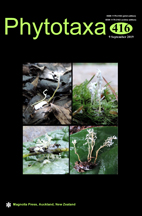Abstract
Raadts (1977) published the combination Kalanchoe nyikae Engler (1895: 189) subsp. auriculata Raadts (1977: 113) (Crassulaceae) to recognise, at the rank of subspecies, material of what she at the time considered to be representatives of the East African K. nyikae that had basally auriculate or cordate, rather than peltate, leaf blades. In 1987 Wickens (1987: 36–37) followed this view and recognised K. nyikae subsp. auriculata and K. nyikae subsp. nyikae. Two years later, Raadts (1989: 171) stated the following about this material: “Diese Sippe wurde wegen der weitgehend übereinstimmenden Blütenmerkmale K. nyikae als Unterart zugeordnet (Raadts 1977[: 113]). Die von der diploiden K. nyikae abweichende Chromosomenzahl 2n=68 deutet jedoch auf eine Hybride hin, hervorgegangen aus einer Kreuzung der K. nyikae subsp. nyikae (2n=34) mit einem hexaploiden Partner (2n=102). Als Kreuzungspartner kommt die hexaploide K. glaucescens in Frage, deren Verbreitungsgebiet mit dem der K. nyikae subsp. nyikae zusammentrifft (Fig. 1, siehe Anhang).” [English: “This material was treated as a subspecies as a result of its floral features that are largely consistent with those of K. nyikae (Raadts 1977[: 113]). However, the chromosome number of 2n = 68, which differs from that of the diploid K. nyikae, indicates that it is a hybrid that arose from a crossing event of K. nyikae [subsp. nyikae] (2n = 34) with a hexaploid (2n = 102) species. As the hexaploid parent, K. glaucescens, the distribution of which overlaps with that of K. nyikae [subsp. nyikae], is brought into question (Figure 1 [on p. 172 of Raadts, 1989], see Appendix [on p. 173 of Raadts, 1989; a list of exsiccatae used for compiling the distribution map on p. 172]).”

